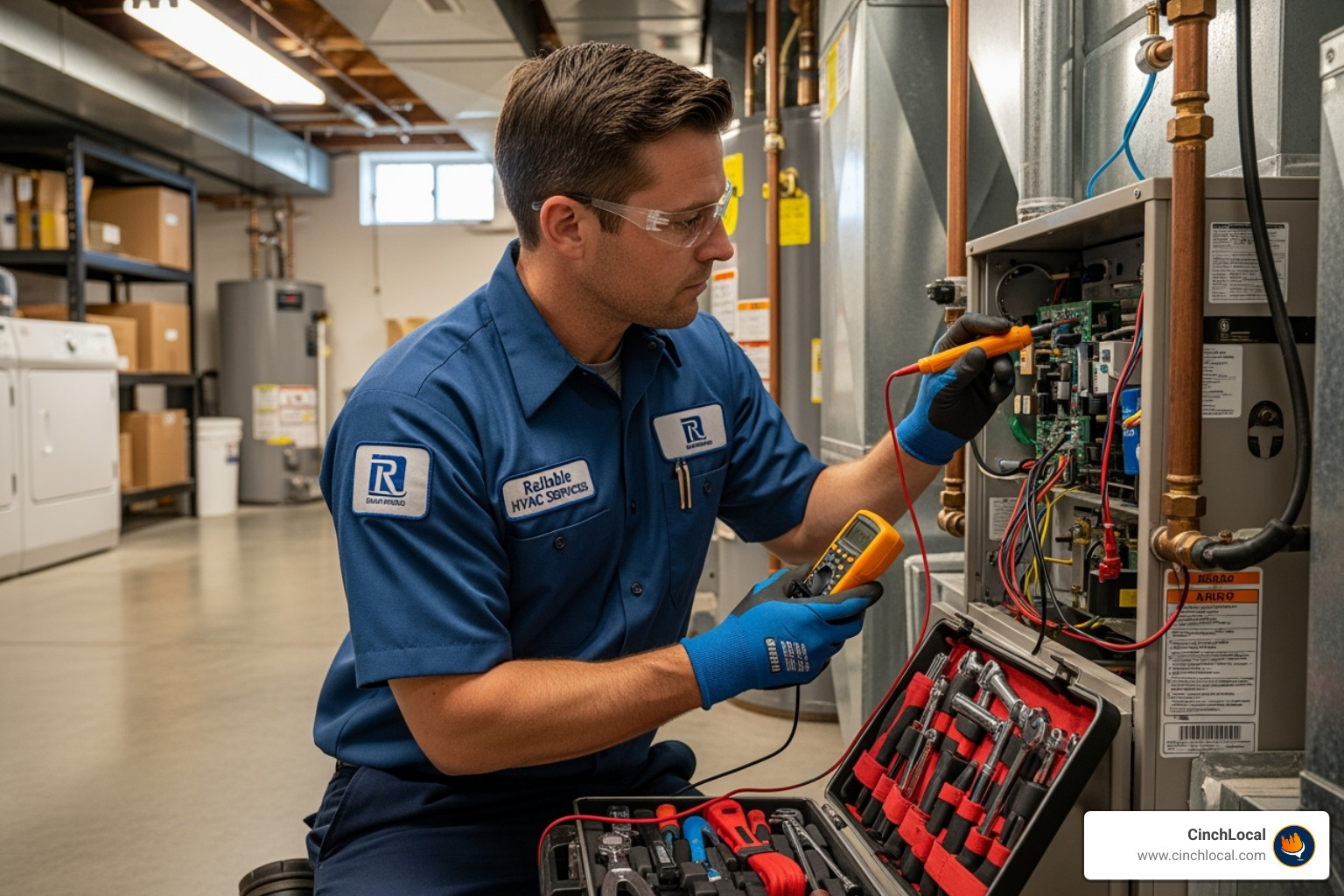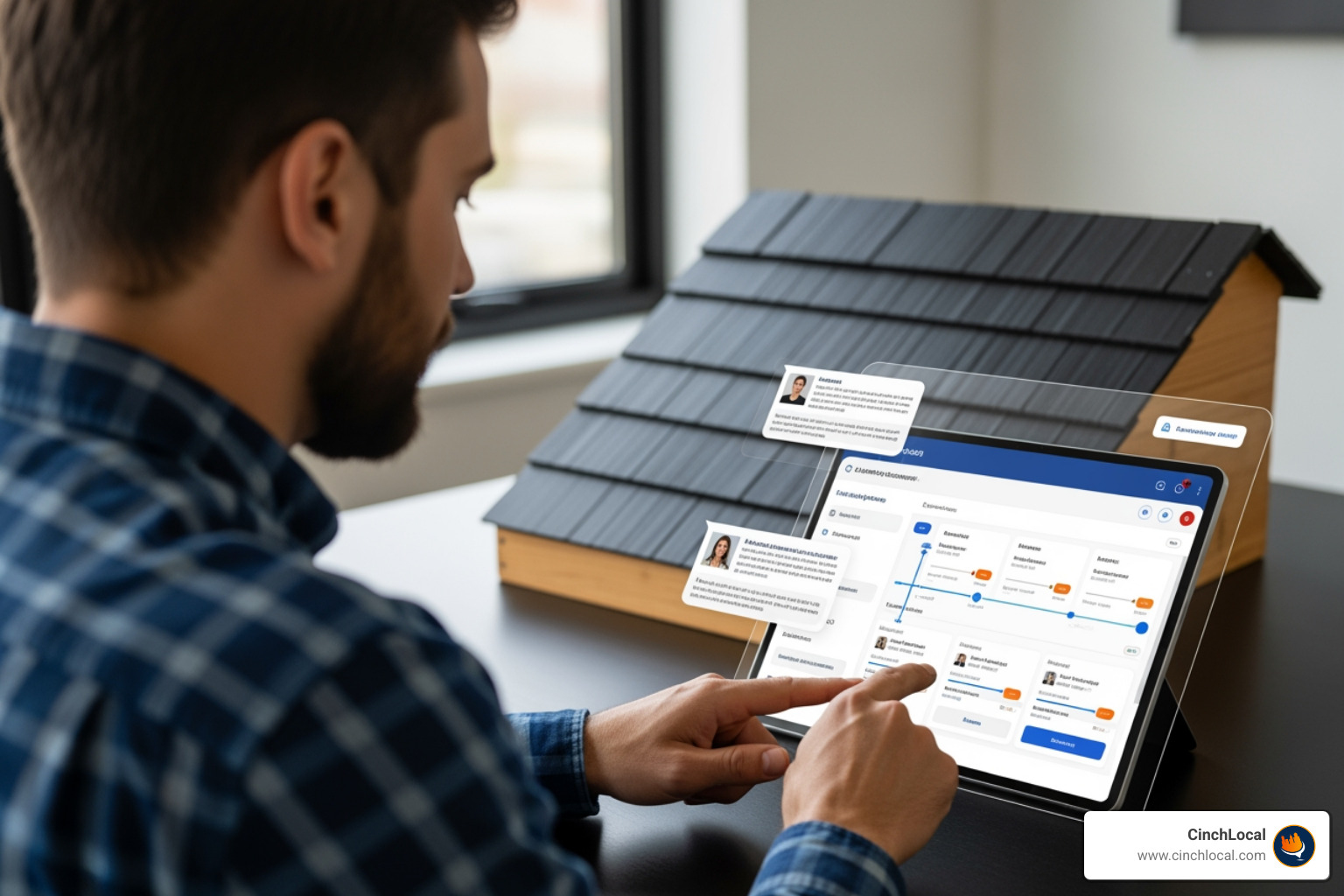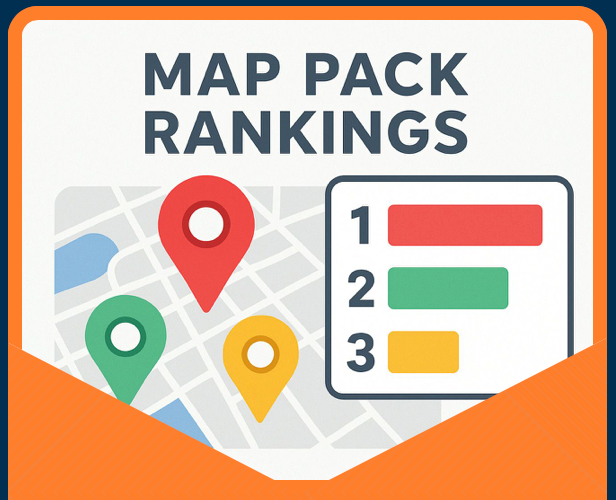
Cary Byrd // Founder of CinchLocal
Roofing Website Design Ideas to Keep Your Business Above the Rest

Why Roofer Website Design Matters in Today's Digital Marketplace
Roofer website design is the foundation of your online presence and often the first impression potential customers have of your business. A well-designed roofing website showcases your services, builds trust, and generates leads.
For roofing contractors looking to improve their online presence, here are the key elements of effective roofer website design:
- Mobile-responsive layout - Over 60% of visitors will access your site on smartphones
- Fast loading speed - Sites should load in under 2 seconds to prevent visitor abandonment
- Clear calls-to-action - Prominent "Get a Free Quote" or "Call Now" buttons
- Trust indicators - Reviews, certifications, and completed project galleries
- Local SEO optimization - Location-specific content and Google Maps integration
The roofing industry is highly competitive online, with local contractors vying for visibility in search results. Your website isn't just a digital brochure—it's a lead-generating tool that works 24/7 to connect you with potential customers.
I'm Cary Byrd, CEO of CinchLocal, and I've helped hundreds of roofing contractors develop high-converting roofer website designs that generate consistent leads and outperform competitors in local search rankings.

Roofer website design glossary: - how to make a roofer website - roofing company website
What Makes a Great Roofer Website Design in 2025
Looking at roofer website design in 2025, I'm seeing a clear shift toward websites that balance aesthetics with functionality that drives leads.
Every successful roofing website needs core pages that guide potential customers: a compelling home page, an about page that builds trust, dedicated service pages, a project gallery, authentic testimonials, and a contact page with multiple ways to reach you. City-specific pages are absolute gold for local SEO.
Speed has become non-negotiable. Your site must load in under two seconds – our data shows that websites taking longer than three seconds lose half their visitors.

With over 60% of traffic now coming from smartphones, a mobile-first approach is essential. Think larger touch targets, readable text without zooming, and intuitive mobile navigation.
Dark themes are trending in roofing websites this year, creating dramatic backdrops that make project photos pop and call-to-action buttons stand out. Just maintain readability with proper contrast.
Trust badges have become increasingly important as homeowners grow cautious about hiring contractors. Prominently display your BBB accreditation, manufacturer certifications, and insurance information.
Sticky CTAs that follow visitors as they scroll ensure you never miss a conversion opportunity. Hero videos have proven to be engagement magnets – just make sure they're properly compressed to avoid slowing down your site.
Top Calls-to-Action for Roofer Website Design
The right calls-to-action transform your website from a digital brochure into a lead-generating machine.
Click-to-call buttons should be everywhere, especially on mobile. Use action phrases like "Call for Your Free Inspection Today" to encourage tapping.
Free inspection forms consistently outperform generic contact forms. Keep them short and make the value proposition clear: "Get Your Free 17-Point Roof Inspection."
Chat widgets capture visitors who have questions but aren't ready to call. Whether live or AI-powered, these tools provide immediate engagement even after hours.
Financing banners often seal the deal for homeowners on the fence. Make these options visible with CTAs like "See If You Qualify in 60 Seconds."
Urgency-driven copy taps into the natural human tendency to avoid missing out. Phrases like "Schedule Before Storm Season" create motivation to act immediately.
Avoid These Common Roofer Website Design Mistakes
Slow hosting is the silent conversion killer. Invest in quality hosting with good server response times – it pays for itself in retained visitors.
Stock photos have their place, but exclusively using generic imagery undermines authenticity. Mix in real photos of your actual team and completed projects.
External manufacturer links leak leads from your site. Keep visitors on your site by embedding product information directly instead of sending them away.
Hidden contact information creates unnecessary friction. Your phone number should be visible on every page, not buried in a footer.
Cluttered menus confuse visitors who just want to find what they need quickly. Stick to clear, logical navigation with no more than 7 main items.
Essential Pages & Features That Turn Clicks Into Leads
When it comes to roofer website design , having the right pages and features isn't just about looking good—it's about creating a conversion machine that turns visitors into customers.
Your homepage serves as your digital storefront. It should immediately answer three critical questions: who you are, what roofing services you provide, and why homeowners should choose you over competitors.
The about page is where you humanize your roofing business. This is your chance to tell your story and introduce the faces behind the company. I've seen conversion rates jump by 30% when contractors add team photos and personal stories.
Service silos are dedicated pages for each specific service you offer. This approach helps visitors find exactly what they need and gives search engines clear signals about your expertise in each area.
City pages might seem tedious to create, but they're absolute gold for local lead generation. Include local landmarks, completed projects in the area, and testimonials from nearby customers to establish your local presence.
A project gallery showcasing your best work is non-negotiable. High-quality before-and-after photos demonstrate your craftsmanship and help potential customers envision what you could do for their property.
Testimonials that breathe and evolve keep your site fresh. Implement a dynamic testimonials widget that pulls recent reviews from Google, Yelp, or other platforms.
An FAQ section addresses common questions while improving your SEO through question-based keywords. A comprehensive FAQ can also reduce time-consuming phone calls about basic information.
Don't forget your financing page. Many homeowners make decisions based on monthly payment affordability rather than total project cost.
| Feature | Template Website | Custom Build |
|---|---|---|
| Initial Cost | $250-1,000 | $2,500-10,000 |
| Monthly Fees | $30-50 | $100-300 |
| Customization | Limited | Unlimited |
| Unique Design | No (shared with competitors) | Yes (one-of-a-kind) |
| SEO Capabilities | Basic | Advanced |
| Loading Speed | Variable | Optimized |
| Lead Generation | Generic forms | Custom conversion tools |
| Ownership | Platform-dependent | Full ownership |
| Scalability | Limited | Highly scalable |
Must-Have Trust & Credibility Boosters
In roofing, where homeowners are making significant investments, trust isn't optional—it's essential.
License and certification badges should be prominently displayed, not hidden in the footer. Your contractor license number, manufacturer certifications, and industry association memberships instantly communicate legitimacy.
Five-star reviews are perhaps your most powerful selling tool. Consider implementing a review carousel that automatically displays your latest positive feedback.

Google evaluates websites based on EEAT signals—Experience, Expertise, Authoritativeness, and Trustworthiness. Boost these signals by including author bios on blog posts, highlighting your years in business, and showcasing industry recognition.
Warranty information reduces perceived risk. Clearly explain both manufacturer material warranties and your workmanship guarantees.
Before-and-after sliders create an interactive experience that powerfully showcases your work. The dramatic visual contrast between a damaged roof and your beautiful finished product creates an emotional response that motivates action.
Smart Integrations for Roofer Website Design
Modern roofer website design goes beyond static pages. The right integrations transform your site from a digital brochure into a lead-generating powerhouse.
CRM synchronization eliminates the gap between your website and your customer management system. When form submissions automatically create new lead records and trigger follow-up sequences, nothing falls through the cracks.
Online scheduling tools reduce friction in the sales process. When homeowners can book appointments directly from your website without playing phone tag, conversion rates typically increase by 15-25%.
Project map integration creates a visual representation of your service history. Tools like DataPins automatically publish completed jobs to your website with geo-coordinates, creating an interactive map that boosts your local SEO signals.
Social proof plugins display real-time notifications when others request quotes or book appointments. These subtle pop-ups create FOMO (fear of missing out) that encourages action.
For more details on how to implement these strategies, check out our comprehensive guide to roofing websites.
User Experience & Mobile Optimization Best Practices
With 61% of website traffic now coming from mobile devices, optimizing for smartphones isn't just nice to have—it's essential for effective roofer website design .
A responsive grid layout forms the foundation of good mobile design. This approach ensures everything on your site automatically adjusts to fit any screen size, keeping your content readable and buttons easily tappable.
Google's Core Web Vitals have become the gold standard for measuring real-world user experience. These technical metrics look at loading performance, interactivity, and visual stability—three factors that directly impact whether visitors stay on your site or bounce back to search results.
One of my favorite techniques for speeding up roofing websites is implementing lazy loading for images and videos. Rather than loading everything at once, elements load only as the visitor scrolls down. This small change can dramatically improve load times, especially for visitors using spotty cell connections.
When it comes to video content, compression is key. Whenever possible, host videos externally on platforms like YouTube or Vimeo to reduce the burden on your server. And please—don't set videos to autoplay with sound!
Form friction is another conversion killer. Every additional field you add to your contact forms reduces completion rates. For initial contact, stick to the essentials: name, phone, email, and perhaps address to verify they're in your service area.
With voice search becoming increasingly popular, make your site voice-search friendly by incorporating natural language phrases into your content. Consider how homeowners might ask Siri or Alexa about roofing services.
For a deeper dive into your site's performance, I highly recommend checking out GTMetrix. This powerful tool provides comprehensive analysis of your site speed and offers specific recommendations for improvement.
Testing Tools Every Roofer Website Design Team Should Use
Google PageSpeed Insights should be your first stop. This free tool analyzes your site's performance on both mobile and desktop devices, providing specific recommendations that even non-technical folks can understand.
The Mobile-Friendly Test from Google specifically evaluates how well your site functions on smartphones and tablets. It highlights usability issues like text that's too small, buttons placed too close together, or content wider than the screen.
Heat mapping tools like Hotjar or Crazy Egg create fascinating visual representations of user behavior. These colorful overlays show exactly where visitors click, how far they scroll, and where they spend time on your pages.
When you're torn between two design approaches, A/B testing platforms like Google Optimize allow you to test different versions of your pages with real visitors. This data-driven approach removes guesswork—let your actual potential customers tell you which headline, form layout, or button color drives more conversions.
SEO & Local Visibility Blueprint for Roofing Sites
When it comes to roofer website design , even the most beautiful site won't generate leads if no one can find it. Search engine optimization is what puts your roofing business on the digital map where potential customers can find you.
Your SEO strategy starts with the fundamentals – every page needs a unique H1 heading that naturally incorporates your primary keyword. Instead of generic "Our Services," use specific headings like "Professional Roof Replacement in Portland" that tell both visitors and search engines exactly what you offer.
Think of your keywords in clusters rather than individual terms. For example, your roof replacement services might include related searches like "new roof installation," "roof tear-off costs," and "complete roof replacement timeline." By addressing these related topics comprehensively, you signal to Google that you're an authority on the subject.
The structure of your website matters tremendously. Implement a silo structure where related content is grouped together through thoughtful internal linking and clear hierarchy. This organization helps search engines understand the relationship between your pages.
For local roofing contractors, Google Maps integration is non-negotiable. Embed maps on your contact page and location-specific service pages to reinforce your local presence.
NAP consistency (Name, Address, Phone) might seem like a small detail, but it's crucial for local search visibility. Even minor variations across your website and online directories can confuse search engines and diminish your visibility.
Service area pages deserve special attention. Create dedicated pages for each city, town, or neighborhood you serve – and make sure they contain truly unique, location-specific content.
For roofing contractors who want to dominate Google Maps visibility (where many emergency roof repair searches happen), check out our detailed guide on Google Maps Local SEO for Roofers.
Creating & Optimizing Local Landing Pages for Roofer Website Design
Local landing pages are the workhorses of your roofer website design when it comes to capturing geo-specific search traffic.
Naturally weave geo-targeted keywords throughout your content – in title tags, meta descriptions, headings, and body text. A page optimized for "Roof Repair in Cleveland" should mention Cleveland contextually throughout the content, not just in the page title.
Nothing builds trust like showing your actual work in a specific area. Integrate project pins or maps displaying completed jobs in each service area. This visual proof of your local presence is far more powerful than simply claiming you serve a location.
The questions homeowners ask about roofing vary by location. Your Milwaukee page might address "How do harsh winters affect roofing materials?" while your Phoenix page discusses "Which roofing materials best withstand intense desert heat?" These location-specific FAQs demonstrate genuine local expertise.
For a deeper dive into creating high-converting local landing pages, visit our comprehensive guide on Creating & Optimizing Local Landing Pages for Roofers.
Real-World Design Inspiration & Cost Breakdown
Looking for inspiration for your roofer website design ? Let's explore some real-world examples that are winning clients and driving leads.
All County Exteriors brilliantly showcases their longevity with a "40 years in business" badge prominently displayed above the fold. This simple yet effective trust signal immediately tells visitors they're dealing with an established company.
ABC Seamless takes a different approach, focusing on visual harmony. Their site maintains perfect color unity throughout – from navigation menus to call-to-action buttons to section headings. This cohesive look creates a polished, professional impression that subtly communicates attention to detail.
Cleveland Commercial Roofing proves that sometimes less is more. Their well-crafted one-page website demonstrates that you don't always need dozens of pages to be effective. For contractors focusing on specific niches, this streamlined approach can create a clear path to conversion.

When it comes to budgeting for your roofer website design , understanding the typical investment ranges helps set realistic expectations:
- Basic template-based sites typically run between $2,500-$4,000
- Mid-range custom designs fall in the $4,000-$7,000 range
- Premium custom sites with advanced features generally cost between $7,000-$10,000
Many roofing marketing agencies (including ours) offer monthly plans starting around $198 with a one-time setup fee of $500. These packages typically include ongoing maintenance, regular updates, and reliable hosting.
Timeframe expectations? Most professional roofer website design projects take about 2-4 weeks from kickoff to launch. This timeline can vary based on how quickly you provide content, approve designs, and offer feedback during the development process.
Looking for more design inspiration? Check out this excellent external gallery of best roofing sites to see various effective styles and elements in action.
Template, Builder, or Custom? Picking the Right Path for Your Roofer Website Design
WordPress CMS powers over 40% of all websites worldwide, and for good reason. It offers the perfect balance of flexibility, customization options, and user-friendliness. For roofing contractors, WordPress provides unlimited growth potential – your site can evolve alongside your business without hitting technical ceilings.
Squarespace shines with its beautiful, modern templates and intuitive interface. If you're a small operation or just getting started, Squarespace can get you online quickly with a professional look. However, be aware of its limitations – advanced functionality and deep SEO optimization can become challenging as your needs grow more complex.
Wix offers appealing drag-and-drop simplicity that makes creating a basic site straightforward. However, roofing contractors should approach with caution due to significant limitations in SEO capabilities, performance metrics, and scalability.
When weighing these options, consider these critical factors:
- Scalability – Will this platform support your growth over the next 3-5 years?
- Ownership – Do you truly own your website and content, or are you essentially "renting" from the platform?
- SEO Capabilities – How well does the platform support the technical aspects of search optimization?
- Integration Options – Can it connect seamlessly with your CRM, scheduling software, and other business tools?
For most established roofing contractors, a custom WordPress site typically offers the best long-term value.
Frequently Asked Questions about Roofer Website Design
How many pages should a roofing website have?
At the bare minimum, your roofing website needs five core pages to function effectively: a compelling Home page, an authentic About Us page that tells your story, a comprehensive Services overview, an impressive Gallery/Portfolio showcasing your best work, and an accessible Contact page that makes reaching you effortless.
However, if you're serious about generating leads and ranking well in search results, I recommend expanding to 15-30 well-developed pages. This expanded structure allows you to create dedicated pages for each specific service you offer, location-specific pages for each city in your service area, and informative blog content that addresses common roofing questions.
Remember though – one thoughtful, well-written page will outperform five hastily created, thin pages every time. Focus on quality content that genuinely helps your visitors.
Should I use WordPress or another CMS?
WordPress stands head and shoulders above other content management systems for roofing websites, and there are compelling reasons why we recommend it to virtually all our roofing clients.
With WordPress powering over 40% of all websites globally, you're getting a platform with best support, regular security updates, and a massive ecosystem of plugins and themes. This matters tremendously when you need to quickly add functionality like appointment scheduling or review displays to your site.
What roofing contractors particularly appreciate about WordPress is its user-friendliness – even team members with limited technical skills can easily update content, add new project photos, or publish blog posts without calling a developer.
While platforms like Squarespace or Wix might seem appealing with their drag-and-drop simplicity, they quickly reveal their limitations when it comes to customization, advanced functionality, and SEO optimization.
How long does it take to launch a new roofing site?
Most professional roofer website design projects take between 2-4 weeks from kickoff to launch, though the timeline can vary based on several factors.
Here's what the typical process looks like:
Week 1: Findy, planning, and wireframing – we learn about your business and create the blueprint-
Week 2: Design approval and content gathering – we finalize the visual direction and collect your materials- Week 3: Development and initial content population – we build the site and begin adding your content-
Week 4: Testing, revisions, and launch preparation – we ensure everything works perfectly before going live
In my experience working with hundreds of roofing contractors, the most common delay comes from gathering quality content and images. To keep your project on schedule, start collecting high-resolution photos of your completed projects, testimonials from satisfied customers, detailed service descriptions, and a comprehensive list of your service areas before the design process even begins.
For more information about creating effective roofing websites, visit our comprehensive guide at CinchLocal's Roofing Websites.
Conclusion
A well-designed roofing website is much more than an online brochure—it's a powerful lead generation tool that works around the clock to connect your business with potential customers. The most effective roofer website designs seamlessly blend attractive visuals with strategic functionality to convert visitors into leads.
Think of your website as your hardest-working employee—one that never sleeps, never takes a day off, and is always ready to make a great first impression. When done right, it becomes the cornerstone of your entire marketing strategy.
As we've explored throughout this guide, successful roofing websites share several key elements that drive results. Your site needs to load quickly—under 2 seconds is the gold standard. It must look and function beautifully on mobile devices, where most of your potential customers will find you. And it should guide visitors naturally toward taking action through strategically placed calls-to-action.
The trust elements we've discussed—from reviews and certifications to project galleries—are particularly crucial in the roofing industry, where homeowners are making significant investments and need reassurance they're choosing the right contractor.
What many contractors overlook is the critical synergy between user experience (UX) and search engine optimization (SEO). A beautiful website that no one can find is just as ineffective as a highly visible site that frustrates visitors. Your roofer website design must excel in both areas to maximize your return on investment.
At CinchLocal, we've specialized exclusively in the roofing industry for years, giving us unique insights into what works specifically for roofing contractors. We understand the seasonal nature of your business, the competitive landscape in different markets, and the exact website elements that drive phone calls and form submissions.
Our Roofer Footprint Expansion System guarantees increased Google Maps visibility and pre-sold leads within 30 days—something generic marketing agencies simply cannot match because they don't have our depth of roofing industry expertise.
Ready to lift your online presence with a professional roofer website design that generates consistent leads? Learn more about our roofing website services and find how we can help your business rise above the competition.
Want Us to Uncover Hidden 'Footprint Gaps' And Critical Blind Spots That’s Quietly Draining Calls, Jobs, and Profits?
Simply Fill Out The Form Below:









